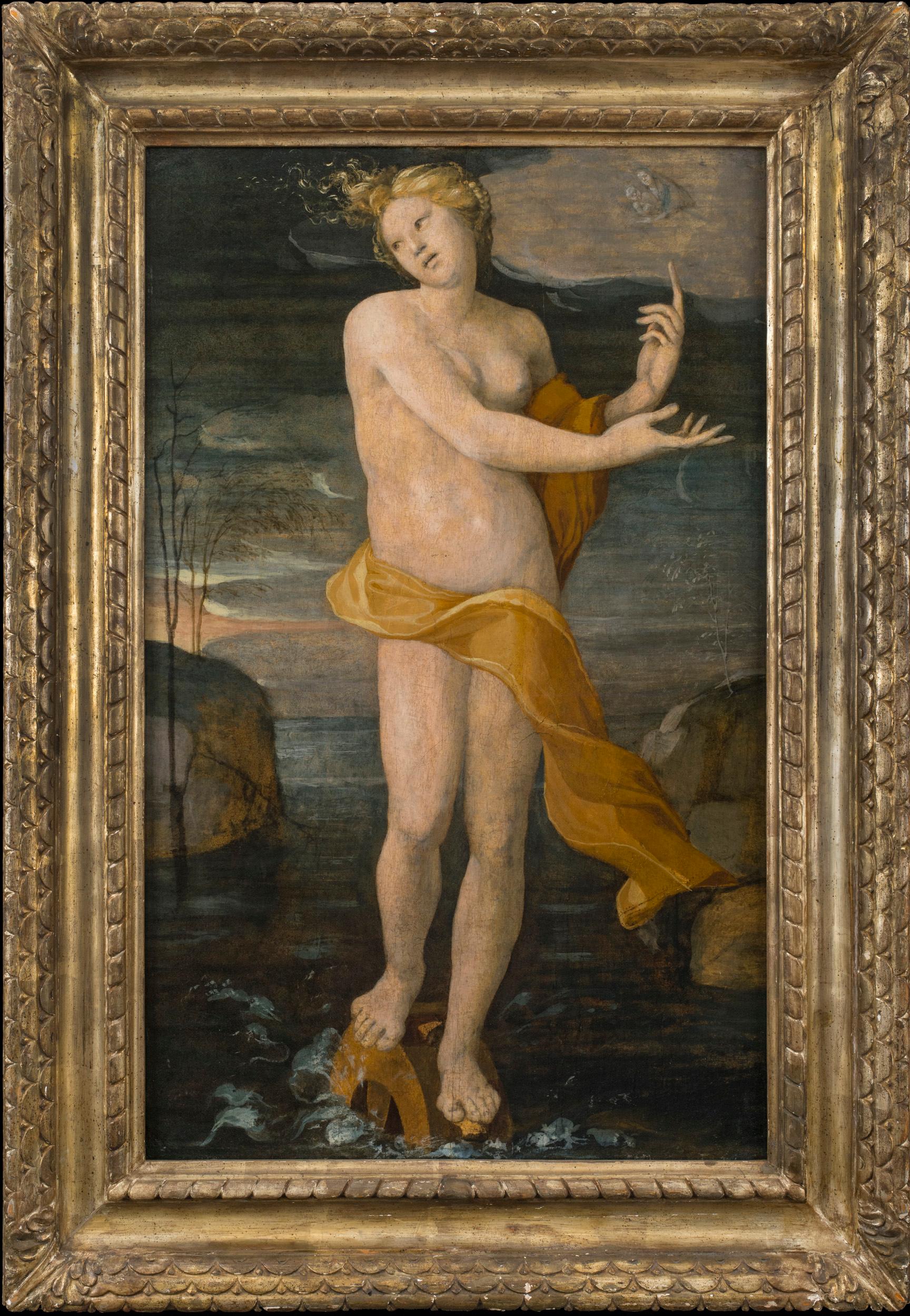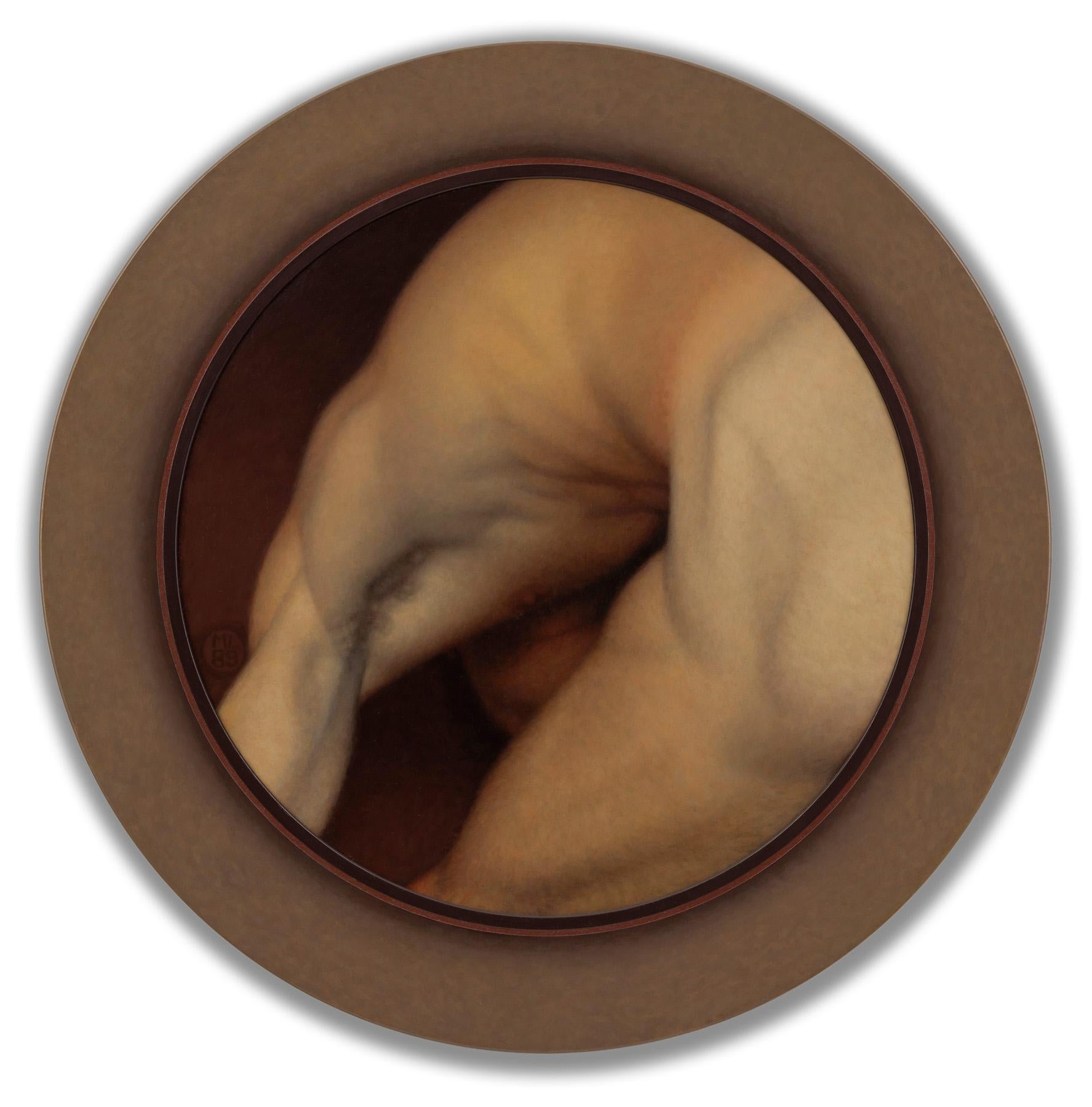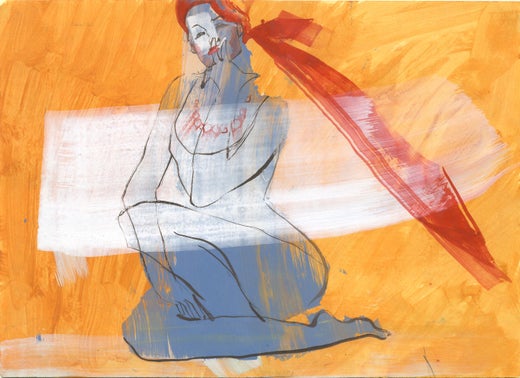Anastasia KurakinaThe Beach - Oil on Canvas by Anastasia Kurakina - 20182018
2018
About the Item
- Creator:Anastasia Kurakina (1987, Russian)
- Creation Year:2018
- Dimensions:Height: 19.69 in (50 cm)Width: 17.72 in (45 cm)Depth: 0.79 in (2 cm)
- Medium:
- Period:
- Condition:Insurance may be requested by customers as additional service, contact us for more information.
- Gallery Location:Roma, IT
- Reference Number:
Anastasia Kurakina
In both her portraits and striking figurative paintings, internationally renowned artist Anastasia Kurakina seeks to deeply probe a subject beyond what can be purely represented in a given piece.
Born in Moscow in 1987, Kurakina spent her childhood surrounded by art, poring over books about the Italian Renaissance at an early age. Her love of art led her to study at several prestigious art schools including the Academy of Fine Arts of Russia, the Academy of Fine Arts Rome, where she obtained a master’s degree in fine art and, in 2018, the Sorbonne University in Paris.
In her figurative, abstract and interior paintings, Kurakina uses rich colors and provocative shapes to explore a bit more than what is eventually represented on the canvas. Throughout her artistic career, Kurakina’s expressive figurative and nude watercolors have garnered critical acclaim, with many critics drawing comparisons to the styles of such masters as Gustav Klimt, David Hockney and others. Since her first exhibition in Moscow in 2005, she has participated in shows around the world, including galleries and museums in Los Angeles, Mexico, London, Milan and elsewhere.
Kurakina’s works are held in the collections of the Nonantola Benedictine Museum and Diocesan Museum of Sacred Art, the Centro Nazionale di Studi Manzoniani, the International Museum of Humor in Art in Tolentino and more.
FInd original Anastasia Kurakina paintings, drawings and watercolor paintings, and more on 1stDibs.
- ShippingRetrieving quote...Ships From: Rome, Italy
- Return PolicyA return for this item may be initiated within 14 days of delivery.
- Lying Nude with Signal 2 - Oil Paint on Canvas by Leo Guida - 1988By Leo GuidaLocated in Roma, ITLying Nude with Signal 2 (Nudo disteso con segnale 2) is an original Contemporary artwork realized in 1988 by the italian Contemporary artist Leo Guida (1992 - 2017). Original oil o...Category
1980s Contemporary Nude Paintings
MaterialsCanvas, Oil
- Lying Nude with Signals 1 - Oil Paint on Canvas by Leo Guida - 1988By Leo GuidaLocated in Roma, ITLying Nude with Signals 1 (Original Title: Nudo disteso con segnali 1) is an original Contemporary artwork realized in 1988 by the italian Contemporary artist Leo Guida (1992 - 2017)...Category
1980s Contemporary Nude Paintings
MaterialsOil, Canvas
- In the Wood - Oil Paint by Antonio Feltrinelli - 1930sBy Antonio FeltrinelliLocated in Roma, ITWoman in the wood is an original modern artwork realized by Antonio Feltrinelli in 1930s Mixed colored oil painting on canvas. Not signed. Antonio Feltrinelli (Milan, 1887 – Gargna...Category
1930s Modern Figurative Paintings
MaterialsOil
- Woman - Painting by Antonio Feltrinelli - 1930sBy Antonio FeltrinelliLocated in Roma, ITWoman is an orignal modern artwork realized by Antonio Feltrinelli in 1930s. Mixed colored oil painting on board Not signed. Antonio Feltrinelli (Milan, 1887 – Gargnano, 1942) He ...Category
1930s Modern Figurative Paintings
MaterialsPaint, Oil
- Veiled Woman - Painting by Antonio Feltrinelli - 1930sBy Antonio FeltrinelliLocated in Roma, ITVeiled woman is an orignal modern artwork realized by Antonio Feltrinelli in 1930s. Mixed colored oil painting on canvas. Not signed. Antonio Feltrine...Category
1930s Modern Figurative Paintings
MaterialsPaint, Oil
- Lying Woman - Oil on Canvas by Nino Bertoletti - 1930/40sBy Nino BertolettiLocated in Roma, ITLying Woman is an original modern artwork realized by the artist Nino Bertoletti beetween 1930 and 1940. Mixed colored oil on canvas. Hand signed by the artist on the lower margin Nino Bertoletti (Rome, October 26...Category
1930s Modern Figurative Paintings
MaterialsOil, Canvas
- [Bruce Sargeant (1898-1938)] Three Bathers by the WaterBy Mark BeardLocated in New York, NY[Bruce Sargeant (1898-1938)] Three Bathers by the Water Signed in red, recto Oil on canvas 96.25 x 67 inches (244.5 x 170.2 cm) $15,000 + $900 framing This work is offered by Cla...Category
Early 2000s Contemporary Paintings
MaterialsCanvas, Masonite, Oil
- Allegory of FortuneLocated in New York, NYProvenance: S. Spinelli Collection, Florence; their sale, Galleria Pesaro, Milan, July 11-14, 1928, lot 112 (unsold); reoffered Galleria Luigi Bellini, Florence, April 23-26, 1934, lot 132, as manner of Baldassare Peruzzi Dr. Giacomo Ancona, Florence, 1930s, and after 1939, San Francisco; thence by descent to his son: Mario Ancona, San Francisco; thence by descent to his children: Mario Ancona III and Victoria Ancona, San Francisco, until 1995; thence to: Phyllis Ancona Green, widow of Mario Ancona, Los Angeles (1995-2012) Literature: Donato Sanminiatelli, Domenico Beccafumi. Milan 1967, p. 170 (under paintings attributed to Beccafumi) Among the precious survivors of Renaissance secular paintings for domestic interiors are several unusual and particularly attractive panels painted in Siena at the end of the fifteenth and beginning of the sixteenth centuries. These paintings depict exemplary figures from antiquity—heroes or heroines, as well as allegorical, literary, and mythological figures. For the most part, these panels have survived in groups of three, although it is possible that some of these works were painted either as part of larger series or as individual projects. One such trio by Beccafumi consists of two paintings now at the National Gallery, London (Marcia and Tanaquil) and a third in the Galleria Doria-Pamphilj, Rome (Cornelia). These were commissioned around 1517–1519 for the bedroom of Francesco di Camillo Petrucci in Siena and were most likely placed together as elements in the wall decoration (spalliere) or installed above the back of a bench or cassapanca. Another, earlier (ca. 1495–1500), set of three—Guidoccio Cozzarelli’s Hippo, Camilla, and Lucretia (Private Collection, Siena) survives with its original wooden framework—a kind of secular triptych. Judith, Sophonisba, and Cleopatra in the collection of the Monte dei Paschi, Siena, are by an anonymous artist close to Beccafumi called the “Master of the Chigi-Saracini Heroines.” Girolamo di Benvenuto’s Cleopatra, Tuccia, and Portia are dispersed (homeless, Prague, Chambery), and Brescianino’s Faith, Hope, and Charity are in the Pinacoteca Nazionale in Siena. The present painting first appeared in the Spinelli sale in Florence in 1934, at which time it was sold with two panels of identical size and format. Each was catalogued as being by the “manner of Baldassare Peruzzi” and of unidentified subject. Of these, the painting depicting a male figure turned to the right has recently reappeared in a private Italian collection, while the location of the third work, portraying a cloaked figure turned three-quarters left, remains unknown. Our panel depicts the allegorical figure of Fortune. Here she is represented in typical fashion as a nude female figure balanced on a wheel (sometimes called the Rota Fortunae), her billowing drapery indicating that she is as changeable as the wind. The appearance of the Virgin and Child in the cloud at the upper right is an unusual addition to the iconography. The subjects of the two pendant male...Category
16th Century Old Masters Paintings
MaterialsOil, Panel
- Hercules and Omphale, Old Master Painting, Mannerism, Baroque, Mythology, PragueLocated in Greven, DEHercules and Omphale Oil on panel, 52 x 41 cm According to legend, Hercules had to make atonement and became a slave to the Lydian queen Omphale. When she found out who her slave was, she married him. Falling for his mistress and made effeminate by the luxury of court life, the former hero allowed himself to become the laughing stock of the court. He dressed in women's clothes, spun wool and did other women's work, whereas Omphale wore his lion's skin and carried a wooden club. When the time of punishment was over, the hero realised his delusion and left Omphale. So far, the painting could not be clearly assigned to an artist. Nevertheless, it impresses with its fluid and convincing painting, whose colourfulness and conception are reminiscent of the Prague School around Bartholomäus Spranger. This work follows an engraving and an etching made by Michel Dorigny in 1643 after a design by Simon Vouet. It shows the same scene but the print differs in minor details from the present painting (see e.g. the head of the lion) and the treatment of the faces seems to be painted more detailed and refined. So far there is no painting...Category
17th Century Baroque Figurative Paintings
MaterialsOil, Panel
- Amor Cutting Bow, Parmigianino, Old Master, Mannerism, Prague, Large PaintingLocated in Greven, DEAlready in the collection of Emperor Rudolf II in the first decade of the 17th century this composition was famous. The original is by Parmigianino and Rudolf's court painter Joseph Heintz...Category
17th Century Mannerist Figurative Paintings
MaterialsCanvas, Oil
- Model undressingLocated in BELEYMAS, FRJulius EXNER (Copenhagen, 1825 - Copenhagen, 1910) Model stripping Oil on canvas H. 122 cm; L. 74 cm Signed and dated 1842 lower right Exhibition: most likely Charlottenborg Salon of 1845, under number 110, titled Modelfigur, awarded with a silver medal Provenance: Emilio Fernando Bolt (c.1860 - 1944), acquired from the artist around 1900, then by descent Our painting was produced as part of the summer sessions organized between 1839 and 1850 by Christoffer Wilhelm Eckersberg (1783-1853), the master of Danish painting of the first half of the 19th century, in his private studio-apartment on the ground floor. floor at the Royal Academy of Fine Arts in Copenhagen. The master brought together a few students there between June and September, rented one or two models for the season, which were painted from different angles, the artists (including Eckersberg himself) sitting side by side. Eckersberg used to paint a fairly small version, the pupils of the larger formats. The work fits more generally into the legendary context of the research and reforms carried out by Eckersberg concerning the studies of nudes and in particular of female nudes, to make this exercise a genre of painting in its own right. Following his two-year stint in Jacques-Louis David's studio in Paris in 1811, Eckersberg had been made aware of work on the nude and in particular on live models, in natural light, while in Denmark the drawings were then only made from casts of antique models or other mannequins. In 1822, when he had been a professor there since 1818, it was he who had the Royal Academy of Copenhagen authorize the study of nudes, no longer in the evening by candlelight, but in natural light; from 1833, it was still he who allowed students to work on nude female models, even if the official authorization of the Academy did not take place until 1839. It was this same year that he instituted his summer sessions, on a private basis, to orient his painting and that of his students towards a new conception of the representation of models: even if the nude remains the real theme, it does not however, this is more than just an academic exercise. The subject is placed in a contemporary interior, with a rather sophisticated decor, and occupied with an intimate activity (it is this type of intimate vein that we will find later in Degas or Cassatt for example); thus in our painting, the young woman is supposed to take off her clothes to wash. The objective is that the viewer forgets that the master and his students are painting a model during a posing session, and that he instead has the impression of being alone with the model, but invisible, almost like a voyeur in spite of himself. Moreover, in these paintings, the model never looks towards the spectator, inducing a psychological distance with him, whereas model and artist are actually physically very close. On the other hand, it is not a question of idealized nudes either, even if Eckersberg, proof of his debt to the antique, chooses fairly classic models and poses. The sensuality is real and very present, with dreamy, even innocent, and timeless expressions (the models do not seem to have a defined age), suave and slow attitudes and movements, and especially with clothes that hide or reveal skillfully parts of the female body: upper buttocks, pronounced hips... Made by an artist under 20, our sensual painting is probably one of the most beautiful and spectacular produced by the students of Eckersberg during these summer sessions. With a perfect balance between the firmness of an ancient statue (it recalls the Venus de Milo) and the softness of the feminine forms, highlighted by a harmonious palette, it captures the attention with many details: the almost photographic folds white clothing...Category
1840s French School Nude Paintings
MaterialsCanvas, Oil
- Man Reaching Down: TondoBy Michael LeonardLocated in London, GBAlkyd-oil on Masonite, signed and dated (middle left), 61cm (diam.), (83cm diam. framed). (This work was kept by the artist for his personal collection. It remained in his collection...Category
1980s Post-War Figurative Paintings
MaterialsOil, Board
![[Bruce Sargeant (1898-1938)] Three Bathers by the Water](https://a.1stdibscdn.com/mark-beard-paintings-bruce-sargeant-1898-1938-three-bathers-by-the-water-for-sale/a_9323/1658516123793/Beard_Three_Bathers_1200_master.jpg)





